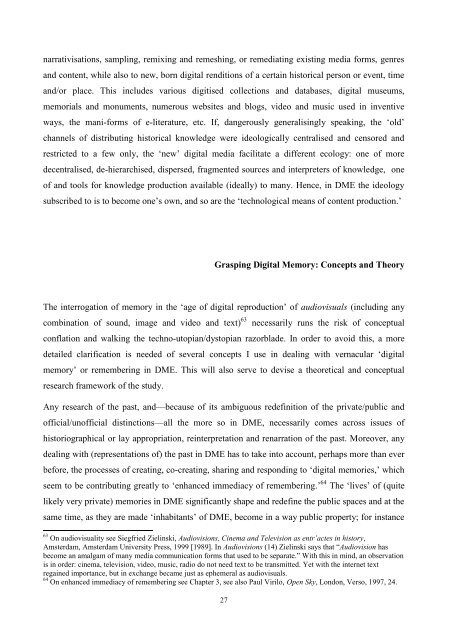UNIVERSITY OF NOVA GORICA GRADUATE SCHOOL ...
UNIVERSITY OF NOVA GORICA GRADUATE SCHOOL ...
UNIVERSITY OF NOVA GORICA GRADUATE SCHOOL ...
You also want an ePaper? Increase the reach of your titles
YUMPU automatically turns print PDFs into web optimized ePapers that Google loves.
narrativisations, sampling, remixing and remeshing, or remediating existing media forms, genres<br />
and content, while also to new, born digital renditions of a certain historical person or event, time<br />
and/or place. This includes various digitised collections and databases, digital museums,<br />
memorials and monuments, numerous websites and blogs, video and music used in inventive<br />
ways, the mani-forms of e-literature, etc. If, dangerously generalisingly speaking, the ‗old‘<br />
channels of distributing historical knowledge were ideologically centralised and censored and<br />
restricted to a few only, the ‗new‘ digital media facilitate a different ecology: one of more<br />
decentralised, de-hierarchised, dispersed, fragmented sources and interpreters of knowledge, one<br />
of and tools for knowledge production available (ideally) to many. Hence, in DME the ideology<br />
subscribed to is to become one‘s own, and so are the ‗technological means of content production.‘<br />
Grasping Digital Memory: Concepts and Theory<br />
The interrogation of memory in the ‗age of digital reproduction‘ of audiovisuals (including any<br />
combination of sound, image and video and text) 63<br />
necessarily runs the risk of conceptual<br />
conflation and walking the techno-utopian/dystopian razorblade. In order to avoid this, a more<br />
detailed clarification is needed of several concepts I use in dealing with vernacular ‗digital<br />
memory‘ or remembering in DME. This will also serve to devise a theoretical and conceptual<br />
research framework of the study.<br />
Any research of the past, and—because of its ambiguous redefinition of the private/public and<br />
official/unofficial distinctions—all the more so in DME, necessarily comes across issues of<br />
historiographical or lay appropriation, reinterpretation and renarration of the past. Moreover, any<br />
dealing with (representations of) the past in DME has to take into account, perhaps more than ever<br />
before, the processes of creating, co-creating, sharing and responding to ‗digital memories,‘ which<br />
seem to be contributing greatly to ‗enhanced immediacy of remembering.‘ 64 The ‗lives‘ of (quite<br />
likely very private) memories in DME significantly shape and redefine the public spaces and at the<br />
same time, as they are made ‗inhabitants‘ of DME, become in a way public property; for instance<br />
63 On audiovisuality see Siegfried Zielinski, Audiovisions, Cinema and Television as entr‘actes in history,<br />
Amsterdam, Amsterdam University Press, 1999 [1989]. In Audiovisions (14) Zielinski says that ―Audiovision has<br />
become an amalgam of many media communication forms that used to be separate.‖ With this in mind, an observation<br />
is in order: cinema, television, video, music, radio do not need text to be transmitted. Yet with the internet text<br />
regained importance, but in exchange became just as ephemeral as audiovisuals.<br />
64 On enhanced immediacy of remembering see Chapter 3, see also Paul Virilo, Open Sky, London, Verso, 1997, 24.<br />
27

















